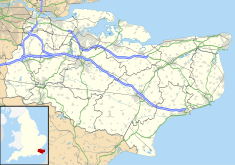| Restoration House | |
|---|---|
 Restoration House from The Vines | |
| Type | House |
| Etymology | Visit of King Charles II on the eve of his restoration |
| Location | Rochester, Kent |
| Coordinates | 51°23′10″N 0°30′16″E / 51.386176°N 0.504451°E |
| OS grid reference | TQ 74363 68213 |
| Earliest phase | 1454 |
| Restored by | Rod Hull and subsequent owners |
| Current use | Home |
| Website | https://www.restorationhouse.co.uk/ |
Listed Building – Grade I | |
| Official name | Restoration House including wall and gate piers attached to front |
| Designated | 24 October 1950 |
| Reference no. | 1185341 |
Listed Building – Grade II | |
| Official name | Remains of summer house in garden 25 metres east of Restoration House |
| Designated | 2 December 1991 |
| Reference no. | 1086519 |
Listed Building – Grade II | |
| Official name | Flint and diapered brick wall at rear of Nos 1 and 3, East Row |
| Designated | 23 January 2008 |
| Reference no. | 1392369 |
Restoration House in Rochester, Kent in England, is a fine example of an Elizabethan mansion. It is so named after the visit of King Charles II on the eve of his restoration.
Charles had landed in Dover on 25 May 1660 and by the evening of the 28th arrived in Rochester. He was received by the Mayor and eventually retired for the night to the home of Colonel Gibbon. The following day Charles continued to London and was proclaimed King on 29 May, his 30th birthday. Although the home of Colonel Gibbon, the property was actually owned by Sir Francis Clerke (he was knighted during the visit), a fact which has led to confusion in the past.[1]
Although it is a private home, the house and garden are open to the public during the summer.[2] The house is protected as a Grade I listed building.[3]
- ^ Restoration House Rochester, An Illustrated History and Guidebook (booklet). (privately published). May 2001.
- ^ "Restoration House". Garden Visit. Retrieved 6 December 2009.
- ^ Historic England. "Restoration House Including Wall And Gatepiers Attached To Front (1185341)". National Heritage List for England. Retrieved 29 January 2020.
